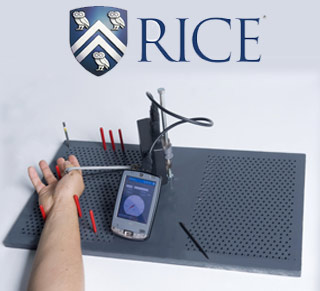
Gloria Gogola, an orthopedic hand surgeon specializing in pediatrics, was noted to have presented a challenge to construct a device that could perfectly evaluate intrinsic hand muscles. These intrinsic hand muscles are known to permit humans to play a piano or perform several tasks which involve dexterity and accuracy. The team is honing in on carpal tunnel syndrome for beginners.
Graduates Caterina Kaffes, Matthew Miller, Neel Shah and Shuai ‘Steve’ Xu were responsible for creating PRIME for their higher assignment. They appeared to be working with the Rice Alliance which assisted in early phase technology project and the Jones Graduate School of Business in order to improve their business plan. In addition, the support of the device was in progress at two foremost Texas Medical Center institutions, the Methodist Hospital and Shriners Hospital for Children.
Xu stated that, “Twenty percent of all ER admissions are hand-related. Neuromuscular disorders like spinal cord injuries, Lou Gehrig’s, diabetes, multiple sclerosis — all these diseases affect the intrinsic hand muscles.â€
He further added that, “U.S. surgeons will perform over 500,000 procedures for carpal tunnel this year. We spend $2 billion per year treating this disease but up to 20 percent of all surgeries need to be redone. Our invention can be used across the spectrum of care from diagnosis to outcome measurements.â€
Doctors are known to test patients’ strength normally by holding the hand in the upward direction and moving it in different ways. Allegedly, the evaluation was through experience, nothing scientific. Xu was noted to have said that previous devices were short of the repeatability which were helpful and also they were unable to manage small hands or abnormal morphologies.
However, PRIME is a device which claims to consist of three elements, namely, a pegboard restraint, a force transducer enclosure and a PDA custom-programmed to capture measurements. A five minute test with this device was believed to allow a doctor to utilize pegs in order to isolate a patient’s individual fingers.
“You wouldn’t think it works as well as it does, but once you are pegged in, you can’t move anything but the finger we want you to,†says Miller.
A ring was observed to have been fixed around the finger. The patient was then advised to shift his finger; thereby measuring the quantity of force produced.
“PRIME gets the peak force. Then the doctor can create a patient-specific file with all your information, time-stamped, and record every single measurement. There’s so much applicability, it’s hard to pinpoint our market size†Xu elucidates.
Gogola elucidates that PRIME seems to have found a home in her clinic.
She reveals, “We’ve been using it on patients, and it’s working very nicely. This particular student group worked extremely hard on the project, and they went above and beyond the course requirements. They took this from a concept to an actual working, clinically useful device.â€
In addition, Xu shared that PRIME combines with existing systems in an accepting manner with the Health Information Portability and Accountability Act, or HIPAA. Xu was observed to expect that PRIME may assist hospitals and rehabilitation clinics in order to compare the efficiency of surgical involvements and identify neuromuscular degenerative diseases.
Rice University team of bioengineering students has won two important awards for their PRIME device.
